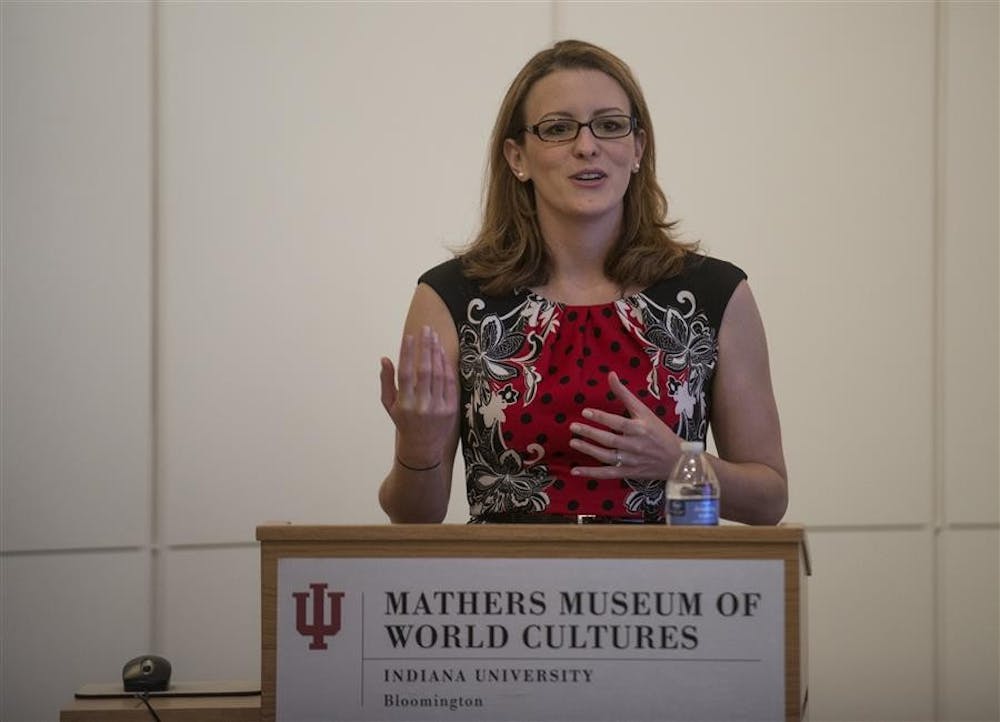A museum gallery in Mallawi, Egypt, is strewn with ancient sarcophagi and broken pottery. Display cases lie in shattered heaps.
“This is what cultural racketeering looks like,” Marion Werkheiser said at her talk at the Mathers Museum of World Cultures last night.
In the chaos of the 2011 Egyptian uprising, Werkheiser said, men with machine guns broke into the Mallawi museum and looted more than 1,000 artifacts.
They burned mummies and broke sculptures too heavy to carry, while archaeologists braved sniper fire from surrounding rooftops to recover valuable objects from the museum before they could stolen or destroyed.
Werkheiser, an IU alumna and former Wells Scholar, is an attorney who works to prevent these heritage sites from becoming warzones. After an active international law career in Washington, D.C., she co-founded Cultural Heritage Partners, an organization that advocates for protection of historical sites worldwide.
Cultural racketeering, Werkheiser said, is the systematic theft of art and antiquities by organized crime syndicates across the globe.
“A necessary factor for this is political unrest,” she said, which was why Egypt was the focus of much of the discussion. “The Egyptian Minister of Antiquities himself has been fired and hired about six times in the past few months.”
Like most other markets in the world economy, illicit trade in art and antiquities has boomed with the tide of globalization. Its total worth is now estimated at $6 billion per year, although Werkheiser suggested the number is probably higher.
Since January 2011, Egypt has lost $2.5 billion in looted antiquities. In that year, the Egyptian government registered 100 times more illegal digs than the previous year.
The black market trade is driven by several factors, Werkheiser said. Most often, and most intuitively, money is the motivator, but in places like Egypt or Bahrain, museums and monuments are often destroyed as political statements.
Werkheiser discussed the fact that trade in illegal art and artifacts is caught up in larger criminal plots around the world — both Sept. 11 collaborators and methamphetamine rings in the American southwest have been found with stolen artifacts that help fund their endeavors.
But many factors in the United States specifically hamper prevention of the illegal artifact trade, Werkheiser said.
The U.S. and Switzerland, both home to many dealers who don’t want to see their pieces return to their countries of origin, have enacted laws making it much harder for source countries to claim ownership of the stolen material.
“We create a lot of hoops,” Werkheiser said.
By the time an artifact has reached a reputable dealer, it could have been through multiple levels of middlemen and launderers, obscuring its source.
Werkheiser finished with talk of solutions. Initiatives around the world use creative methods to combat the loss of cultural artifacts, including crowd sourced reporting, social media, and entrepreneurship efforts focused on tourism, she said.
“Building economies around these sites increases incentive to care for them,” Werkheiser said. “Antiquities have been viewed as a sort of cash crop. We’re trying to redirect that so they can make money while keeping the artifacts in the ground — to feed their families through tourism.”
Werkheiser brought the issue home when she mentioned a Rush County, Ind., collector whose home was seized in an FBI art crime team raid Wednesday.
“I can’t wait to hear more about it,” she said.
Follow reporter Steven Johnson on Twitter @stetyjohn.
Alumna speaks on black market trade at home and abroad

Get stories like this in your inbox
Subscribe





